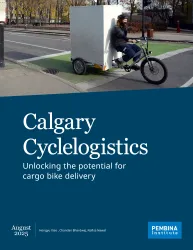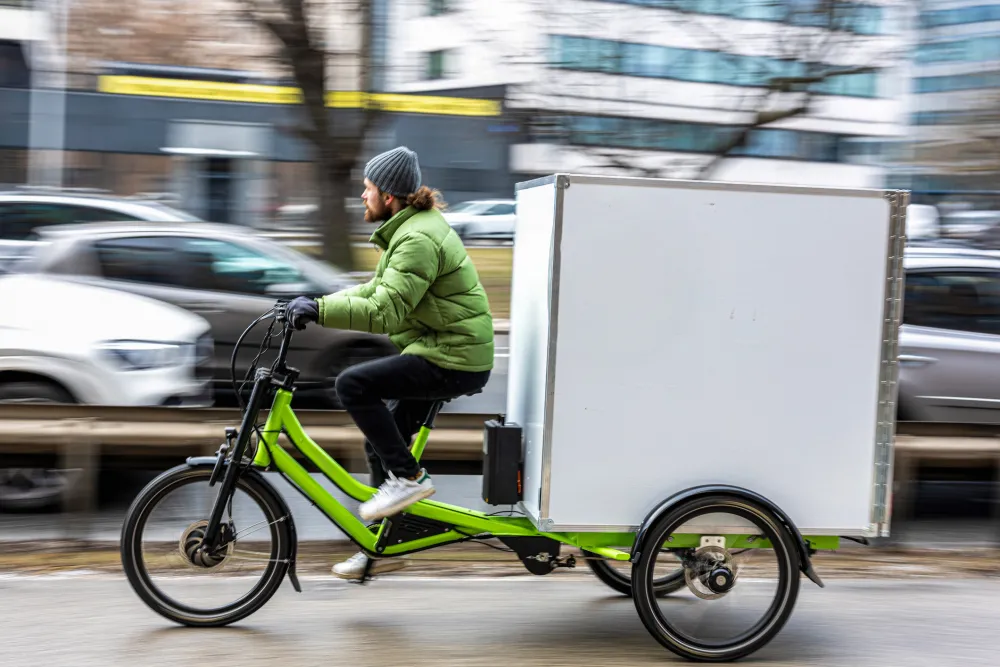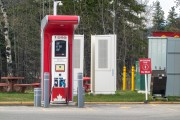Alberta’s debates over bike lanes often focus on commuters, but an overlooked opportunity is using bikes for business. While most people turn to online shopping for convenience, it can also slow our cities down. In Calgary, the surge in e-commerce is putting more delivery vans on already crowded streets, contributing to congestion and declining air quality.
Calgary’s transportation and warehousing sectors employ thousands and contribute nearly $7 billion to the city’s GDP (2o23). They could benefit from a cleaner, more efficient alternative for delivery. Cargo e-bikes offer a solution that cuts pollution, eases traffic and helps local businesses compete.
Online orders, offline impact
The transportation sector accounts for roughly 34% of Calgary’s greenhouse gas (GHG) emissions, with on-road freight responsible for about 62% of vehicle emissions across Alberta. Every day, more than 120,000 truck trips occur in Calgary, and truck traffic has increased by over 55% between 1996 and 2021. The Calgary International Airport further adds to freight emissions, handling 75% of Alberta’s air cargo and ranking as Canada’s second-busiest airport for air freight.
More trucks on the road mean more traffic and air pollution — with real consequences for the health and well-being of Calgary residents.
Diesel trucks emit major pollutants such as nitrogen oxide and fine particulate matter, which can cause heart and respiratory diseases and even premature death. According to Health Canada, traffic-related air pollution is linked to about two premature deaths per 100,000 people in Calgary and the surrounding region.
These impacts highlight the need for alternatives in how Calgary moves goods.
Rethinking urban delivery
How can Calgary meet the growing demand for goods movement, a key economic driver, while also reducing its negative impacts? Through cyclelogistics, which involves replacing a portion of delivery trucks and vans with cargo e-bikes.
Cargo e-bikes allow businesses of all sizes to move goods efficiently through urban streets, cost less than vans or trucks, provide savings through reduced fuel use and speed up travel in high-traffic areas. By taking some deliveries off trucks and moving them onto cargo e-bikes, Calgary can curb truck and van kilometres, along with related emissions, congestion and other urban freight impacts.
Based on interviews we've done with various businesses and stakeholders across Calgary, interest in cargo e-bike delivery is growing. However, municipal government support is essential to making it viable at scale. Without strong leadership, uptake will remain limited.
Calgary has recognized bikes and zero-emission transport in its climate and transportation goals. However, for cyclelogistics to succeed, Calgary needs the right infrastructure, such as microhubs, charging stations and safe, designated parking, alongside strong policies and regulations.
Six actions to get cargo e-bikes rolling
To help make that happen, our latest research on urban goods movement in Calgary identifies six actions the City of Calgary can take to expand cargo e-bike use. Sustainable and effective cargo e-bike adoption depends on engaging businesses, logistics providers, residents and equity-deserving communities at every step — ensuring that cyclelogistics benefits the city as a whole.
Support business development of cyclelogistics microhubs
Microhubs are small facilities near final delivery points where goods are prepared and sorted for final delivery. By piloting microhubs and providing guidance for managing them, Calgary can help businesses deliver by cargo e-bike more efficiently — getting goods to customers faster while reducing traffic. Updating bylaws to streamline permits, simplifying approvals, or improving tax and rent policies could make these hubs easier to launch and operate.
Expand cycle infrastructure and re-evaluate design guidelines
Cargo e-bikes can be an effective transportation solution in high-density areas, especially during peak delivery hours. By widening bike lanes, adding passing zones, improving turning paths and targeting key routes, Calgary can better connect microhubs, residents and businesses.
Alongside these upgrades, working with stakeholders to identify optimal locations for microhubs, bike parking and charging infrastructure will be key to maximizing effectiveness.
Create a cargo e-bike sharing program in Calgary’s Business Improvement Areas
Calgary can help Business Improvement Areas launch a cargo e-bike sharing program, giving local businesses flexible access to shared bikes without large upfront costs. By pooling demand, the program becomes cost-effective, encourages regular use and helps businesses move goods efficiently.
Start a cargo e-bike pilot program
Many businesses may still be on the fence about cargo e-bikes and want a clearer sense of the business case. By partnering with logistics companies, Calgary can run cargo e-bike pilot programs to test their viability.
Cities like Boston and Toronto have successfully led pilots that helped businesses plan routes, secure bikes and manage deliveries. Pilots build confidence, provide lessons for other companies and pave the way for sustainable expansion.
Facilitate cyclelogistics awareness and knowledge-building
Calgary’s car dependency means many businesses are unaware of cargo e-bike options or aren’t sure how to use them. Calgary can focus outreach on the communities where it will have the greatest impact and work with businesses to create a practical cargo e-bike guide and a regularly updated information hub.
Clear information on costs, bike capacity, delivery logistics and day-to-day operations can help businesses confidently adopt cargo e-bikes.
Update bylaws, regulations and standards to facilitate cargo e-bikes
Clear and consistent rules for parking, sidewalk access, loading zones and microhub placement reduce confusion, ensure rider safety, decrease liability and support cargo e-bike uptake. The same applies to infrastructure design standards, such as bike signage, delivery-friendly parking and charging options.
New York City’s “green loading zones” provide a strong example of how clear regulations can promote safer and more efficient operations.
Make cargo e-bikes a part of Calgary’s transportation future

Urban goods movement is central to Calgary’s economy and by implementing policies outlined in our new report — from expanding infrastructure and microhubs to updating regulations and launching pilot programs — Calgary can make cargo e-bikes a practical and sustainable part of urban deliveries. This is a chance to cut pollution, ease congestion and give businesses a competitive edge, while setting an example for cities across Canada.
To learn more about how cargo e-bikes can transform Calgary, read our full report: Calgary Cyclelogistics: Unlocking the potential for cargo bike delivery.







